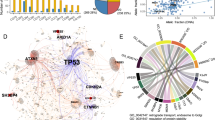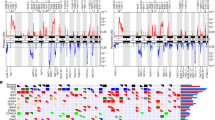Abstract
Hepatocellular carcinoma (HCC) is one of the most common cancers worldwide and shows a propensity to metastasize and infiltrate adjacent and more distant tissues1. HCC is associated with multiple risk factors, including hepatitis B virus (HBV) infection, which is especially prevalent in China. Here, we used exome sequencing to identify somatic mutations in ten HBV-positive individuals with HCC with portal vein tumor thromboses (PVTTs), intrahepatic metastases. Both C:G>A:T and T:A>A:T transversions were frequently found among the 331 non-silent mutations. Notably, ARID1A, which encodes a component of the SWI/SNF chromatin remodeling complex, was mutated in 14 of 110 (13%) HBV-associated HCC specimens. We used RNA interference to assess the roles of 91 of the confirmed mutated genes in cellular survival. The results suggest that seven of these genes, including VCAM1 and CDK14, may confer growth and infiltration capacity to HCC cells. This study provides a view of the landscape of somatic mutations that may be implicated in advanced HCC.
This is a preview of subscription content, access via your institution
Access options
Subscribe to this journal
Receive 12 print issues and online access
$209.00 per year
only $17.42 per issue
Buy this article
- Purchase on Springer Link
- Instant access to full article PDF
Prices may be subject to local taxes which are calculated during checkout




Similar content being viewed by others
Accession codes
References
Bosch, F.X., Ribes, J., Diaz, M. & Cleries, R. Primary liver cancer: worldwide incidence and trends. Gastroenterology 127, S5–S16 (2004).
Liver Cancer Study Group of Japan. Primary liver cancer in Japan. Clinicopathologic features and results of surgical treatment. Ann. Surg. 211, 277–287 (1990).
Llovet, J.M. et al. Natural history of untreated nonsurgical hepatocellular carcinoma: rationale for the design and evaluation of therapeutic trials. Hepatology 29, 62–67 (1999).
Totoki, Y. et al. High-resolution characterization of a hepatocellular carcinoma genome. Nat. Genet. 43, 464–469 (2011).
Sjöblom, T. et al. The consensus coding sequences of human breast and colorectal cancers. Science 314, 268–274 (2006).
Wood, L.D. et al. The genomic landscapes of human breast and colorectal cancers. Science 318, 1108–1113 (2007).
Parsons, D.W. et al. An integrated genomic analysis of human glioblastoma multiforme. Science 321, 1807–1812 (2008).
Jones, S. et al. Core signaling pathways in human pancreatic cancers revealed by global genomic analyses. Science 321, 1801–1806 (2008).
Hussain, S.P., Schwank, J., Staib, F., Wang, X.W. & Harris, C.C. TP53 mutations and hepatocellular carcinoma: insights into the etiology and pathogenesis of liver cancer. Oncogene 26, 2166–2176 (2007).
Aguilar, F., Hussain, S.P. & Cerutti, P. Aflatoxin B1 induces the transversion of G––>T in codon 249 of the p53 tumor suppressor gene in human hepatocytes. Proc. Natl. Acad. Sci. USA 90, 8586–8590 (1993).
Hsu, I.C. et al. Mutational hotspot in the p53 gene in human hepatocellular carcinomas. Nature 350, 427–428 (1991).
Besaratinia, A., Kim, S.I., Hainaut, P. & Pfeifer, G.P. In vitro recapitulating of TP53 mutagenesis in hepatocellular carcinoma associated with dietary aflatoxin B1 exposure. Gastroenterology 137, 1127–1137 (2009).
Arlt, V.M., Stiborova, M. & Schmeiser, H.H. Aristolochic acid as a probable human cancer hazard in herbal remedies: a review. Mutagenesis 17, 265–277 (2002).
Moriya, M. et al. TP53 mutational signature for aristolochic acid: an environmental carcinogen. Int. J. Cancer 129, 1532–1536 (2011).
Wang, Y. et al. Aristolochic acid–induced carcinogenesis examined by ACB-PCR quantification of H–Ras and K–Ras mutant fraction. Mutagenesis 26, 619–628 (2011).
Barbin, A. Etheno-adduct-forming chemicals: from mutagenicity testing to tumor mutation spectra. Mutat. Res. 462, 55–69 (2000).
Staib, F., Hussain, S.P., Hofseth, L.J., Wang, X.W. & Harris, C.C. TP53 and liver carcinogenesis. Hum. Mutat. 21, 201–216 (2003).
Imbeaud, S., Ladeiro, Y. & Zucman–Rossi, J. Identification of novel oncogenes and tumor suppressors in hepatocellular carcinoma. Semin. Liver Dis. 30, 75–86 (2010).
Li, M. et al. Inactivating mutations of the chromatin remodeling gene ARID2 in hepatocellular carcinoma. Nat. Genet. 43, 828–829 (2011).
Jones, S. et al. Frequent mutations of chromatin remodeling gene ARID1A in ovarian clear cell carcinoma. Science 330, 228–231 (2010).
Wiegand, K.C. et al. ARID1A mutations in endometriosis-associated ovarian carcinomas. N. Engl. J. Med. 363, 1532–1543 (2010).
Gui, Y. et al. Frequent mutations of chromatin remodeling genes in transitional cell carcinoma of the bladder. Nat. Genet. 43, 875–878 (2011).
Wang, K. et al. Exome sequencing identifies frequent mutation of ARID1A in molecular subtypes of gastric cancer. Nat. Genet. 43, 1219–1223 (2011).
Topaz, O. et al. A deleterious mutation in SAMD9 causes normophosphatemic familial tumoral calcinosis. Am. J. Hum. Genet. 79, 759–764 (2006).
Li, Y. et al. Stepwise metastatic human hepatocellular carcinoma cell model system with multiple metastatic potentials established through consecutive in vivo selection and studies on metastatic characteristics. J. Cancer Res. Clin. Oncol. 130, 460–468 (2004).
Tang, Z.Y. et al. A decade's studies on metastasis of hepatocellular carcinoma. J. Cancer Res. Clin. Oncol. 130, 187–196 (2004).
Stratton, M.R., Campbell, P.J. & Futreal, P.A. The cancer genome. Nature 458, 719–724 (2009).
Wong, K.M., Hudson, T.J. & McPherson, J.D. Unraveling the genetics of cancer: genome sequencing and beyond. Annu. Rev. Genomics Hum. Genet. 12, 407–430 (2011).
Shu, F. et al. Functional characterization of human PFTK1 as a cyclin-dependent kinase. Proc. Natl. Acad. Sci. USA 104, 9248–9253 (2007).
Leung, W.K. et al. A novel interplay between oncogenic PFTK1 protein kinase and tumor suppressor TAGLN2 in the control of liver cancer cell motility. Oncogene 30, 4464–4475 (2011).
Li, H., Ruan, J. & Durbin, R. Mapping short DNA sequencing reads and calling variants using mapping quality scores. Genome Res. 18, 1851–1858 (2008).
McKenna, A. et al. The Genome Analysis Toolkit: a MapReduce framework for analyzing next-generation DNA sequencing data. Genome Res. 20, 1297–1303 (2010).
Koboldt, D.C. et al. VarScan: variant detection in massively parallel sequencing of individual and pooled samples. Bioinformatics 25, 2283–2285 (2009).
Robinson, J.T. et al. Integrative Genomics Viewer. Nat. Biotechnol. 29, 24–26 (2011).
Huang, W., Sherman, B.T. & Lempicki, R.A. Systematic and integrative analysis of large gene lists using DAVID Bioinformatics Resources. Nat. Protoc. 4, 44–57 (2009).
Huang, W., Sherman, B.T. & Lempicki, R.A. Bioinformatics enrichment tools: paths toward the comprehensive functional analysis of large gene lists. Nucleic Acids Res. 37, 1–13 (2009).
Boutros, M., Brás, L.P. & Huber, W. Analysis of cell-based RNAi screens. Genome Biol. 7, R66 (2006).
Acknowledgements
We gratefully acknowledge support from the Chinese National Key Program on Basic Research (2010CB529204 and 2010CB529206), the China National Key Projects for Infectious Disease (2012ZX10002012-008), the National Natural Science Foundation of China (81071722 and 81101875), the Shanghai Commission for Science and Technology (11ZR1425300), the International Scientific Collaborative Project (2011ZR0001) and the National High Technology Research and Development Program of China (863 Program, 2012AA02A205 and SS2012AA020103).
Author information
Authors and Affiliations
Contributions
Z.-G.H. conceived and designed the study. Q.D., J.H., Z.-D.Z. and H.-S.X. performed exome sequencing and analyzed the sequence data set. Q.D., Q.W., K.-Y.L., J.-H.D., R.-F.L. and H.C. evaluated mutations in HCC samples. Q.D. and N.L. performed large-scale RNA interference against mutated genes. Q.D., Q.W., K.-Y.L., N.L., Bo Zhou, X.-Y.L. and Q.-L.F. performed in vitro experiments on individual genes. B.C., Boping Zhou and L.-X.Q. contributed HCC samples. Z.-G.H. and Q.D. integrated, analyzed and interpreted all data. Z.-G.H. contributed to the supervision of the work. Z.-G.H. and Q.D. wrote the manuscript. All authors read and approved the final version of the manuscript.
Corresponding author
Ethics declarations
Competing interests
The authors declare no competing financial interests.
Supplementary information
Supplementary Text and Figures
Supplementary Note, Supplementary Figures 1–17 and Supplementary Tables 1, 2, 6 and 8–14 (PDF 3710 kb)
Supplementary Table 3
Potential somatic base substitution mutations were identified using massively parallel sequencings (XLSX 110 kb)
Supplementary Table 4
The 682 potential non-silent somatic mutations identified using massively parallel sequencings (XLSX 93 kb)
Supplementary Table 5
The 347 genes harboring non-silent SNVs and indel mutations (XLSX 66 kb)
Supplementary Table 7
The mutation patterns between the primary tumors and the matched PVTTs (XLSX 67 kb)
Rights and permissions
About this article
Cite this article
Huang, J., Deng, Q., Wang, Q. et al. Exome sequencing of hepatitis B virus–associated hepatocellular carcinoma. Nat Genet 44, 1117–1121 (2012). https://doi.org/10.1038/ng.2391
Received:
Accepted:
Published:
Issue Date:
DOI: https://doi.org/10.1038/ng.2391
This article is cited by
-
Characterization of the Immune Infiltration Landscape and Identification of Prognostic Biomarkers for Esophageal Cancer
Molecular Biotechnology (2023)
-
Sparse logistic regression revealed the associations between HBV PreS quasispecies and hepatocellular carcinoma
Virology Journal (2022)
-
VCAM1 confers innate immune tolerance on haematopoietic and leukaemic stem cells
Nature Cell Biology (2022)
-
Identification and validation of a five-gene prognostic signature for hepatocellular carcinoma
World Journal of Surgical Oncology (2021)
-
A radiosensitizer, gallotannin-rich extract from Bouea macrophylla seeds, inhibits radiation-induced epithelial-mesenchymal transition in breast cancer cells
BMC Complementary Medicine and Therapies (2021)



